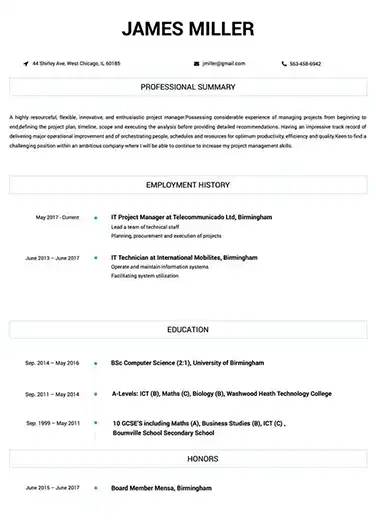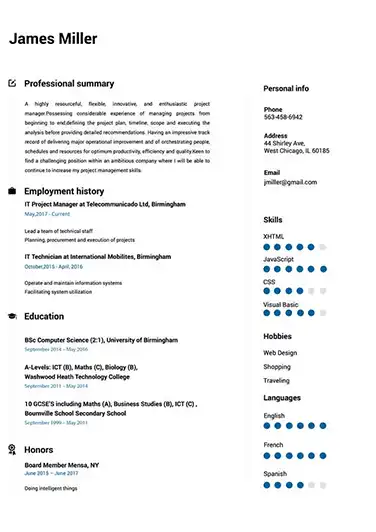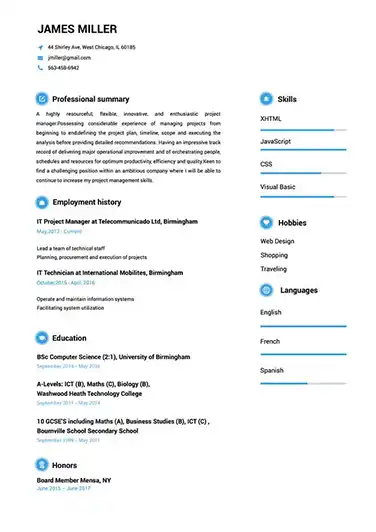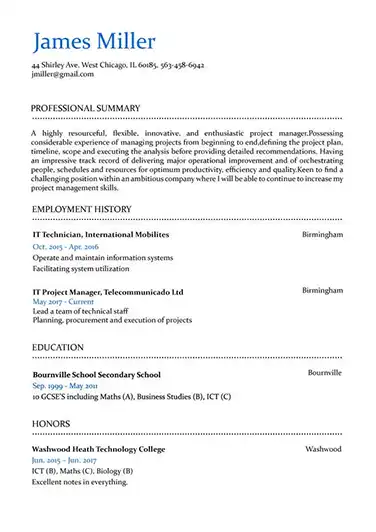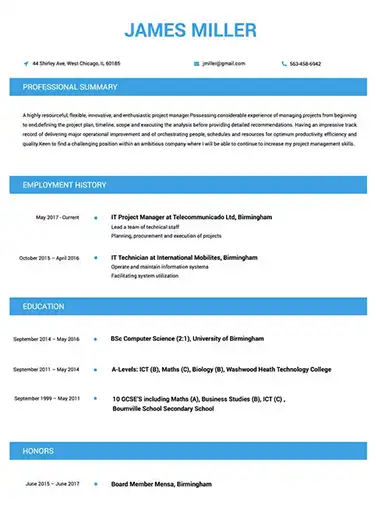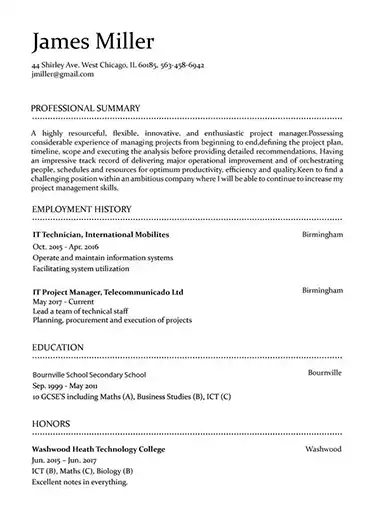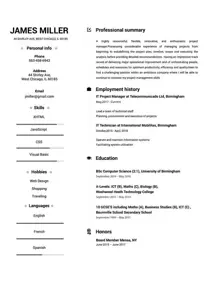 Use This Template
Use This Template
Build your resume in 15 minutes
Create an awesome resume that meets the expectations of potential employers with our selection of professional, field-tested resume templates.
pilot: Resume Samples & Writing Guide
scott-larry@zoho.com
651-568-0189
Employment history
- Monitor and adjust aircraft systems as needed
- Supervise and coordinate ground crew activities
- Perform post-flight inspections and complete flight reports
- Perform pre-flight inspections and complete flight documentation
- Monitor aircraft performance and make adjustments as necessary
- Perform post-flight inspections and complete flight reports
- Maintain knowledge of emergency and safety procedures
- Monitor aircraft performance and make adjustments as necessary
- Monitor and adjust aircraft systems as needed
Education
Skills
Do you already have a resume? Use our PDF converter and edit your resume.
robinsonsteve@hotmail.com
738-999-0382
Employment history
- Manage aircraft systems such as navigation and fuel
- Perform post-flight inspections and complete flight reports
- Monitor aircraft performance and make adjustments as necessary
- Ensure passengers and cargo are safely secured
- Monitor aircraft performance and adjust as necessary
- Maintain proficiency in aircraft operations and safety regulations
- Supervise and coordinate ground crew activities
- Manage aircraft systems such as navigation and fuel
- Perform pre-flight inspections and complete flight documentation
Education
Skills
harriskyle@outlook.com
905-271-6840
Professional Summary
Employment history
- Prepare and file flight plans
- Maintain knowledge of emergency and safety procedures
- Perform post-flight inspections and complete flight reports
- Perform post-flight inspections and complete flight reports
- Maintain knowledge of emergency and safety procedures
- Monitor and adjust aircraft systems as needed
- Monitor aircraft performance and make adjustments as necessary
- Monitor weather conditions and adjust flight plans accordingly
- Operate aircraft according to Federal Aviation Administration (FAA) regulations
Education
Skills
graysteve@yahoo.com
808-094-9653
Employment history
- Operate aircraft according to Federal Aviation Administration (FAA) regulations
- Perform post-flight inspections and complete flight reports
- Monitor weather conditions and adjust flight plans accordingly
Education
Skills
nateroberts91@aol.com
629-140-4372
Professional Summary
Employment history
- Manage aircraft systems such as navigation and fuel
- Monitor and adjust aircraft systems as needed
- Monitor aircraft performance and make adjustments as necessary
- Monitor aircraft performance and make adjustments as necessary
- Manage aircraft maintenance and repairs
- Maintain proficiency in aircraft operations and safety regulations
- Perform pre-flight inspections and complete flight documentation
- Maintain proficiency in aircraft operations and safety regulations
- Operate aircraft according to Federal Aviation Administration (FAA) regulations
Education
Skills
Not in love with this template? Browse our full library of resume templates
From the outside, the life of a pilot appears to be incredibly glamorous. You constantly get to travel to new parts of the world, earn an excellent salary, and enjoy the prestige, which comes with the job title.
What most people fail to appreciate, however, is how demanding your job is. They also don’t realize the blood, sweat, and tears it took to become a pilot in the first place. Let alone that you had to study and undertake your pilot’s training for what seemed like years on end, you also had to log a certain amount of hours in the air and pass several exams to finally call yourself a pilot.
Now, as a fully-fledged pilot, you’re responsible for the safety of thousands of passengers a year - or a few bigwig clients if you’re flying private! Or perhaps you’re flying cargo, which carries a whole other set of responsibilities with it. One thing that’s for sure is that while there’s nothing in the world as thrilling as flying, it’s no walk in the park.
One aspect of your profession that’s especially challenging is trying to secure a new job. After all, there are only so many positions available, so competition is fierce. The Bureau of Statistics projects that overall employment of airline and commercial pilots will grow by 6 percent from 2018 to 2028. While this doesn’t sound too bad, keep in mind that this is only 1% more than the average for all occupations.
But it’s not all doom and gloom. In fact, once you know how to properly leverage the key to impressing recruiters, you’ll have more job offers than you can handle! What, then, is the key? Your pilot resume. It has the potential to open doors to all kinds of professional opportunities - including flying with your dream airline or plane.
You just need to know how to make a pilot resume recruiters will scramble to read. If you’re ready to transform your resume, read our guide below. It covers each aspect of your creating the perfect resume including:
- Which skills you need to highlight and how to do it correctly
- The best way to list your flight times and ratings
- Tips for writing your resume objective or summary
- Expert advice for targeting your resume to each application
- How to distinguish your resume from the competition
1. Multiple Template Examples
2. How to write a pilot resume that will get you the job?
How to format it
As a pilot, you need to project professionalism in every facet of your being. Given that your resume is a written representation of your achievements as a pilot, it is vital that it appears to be just as professional as you are.
For this reason, we strongly advise that you make use of a reverse-chronological resume format. This format is the industry standard for pilots as it lets your work history take center stage, by featuring your work history prominently on your resume and arranging it from your most to least recent job.
In order for your resume to be well-received by recruiters, you will also need to ensure you have followed the standard layout rules we have outlined below:
- Number of Pages: 1 page only.
- Fonts to Use: Any font that looks authoritative, such as Cambria and Garamond.
- Fonts to Avoid: Any font that makes the recruiter question your professionalism, such as Bradel Hand ITC and Vivaldi.
- Margins: 1 inch on all sides.
- Line Spacing: 1 or 1.15.
- Header size: 14-16 point size.
- Text size: 11-12 point size
What recruiters will look for
While recruiters for most jobs will settle with a candidate who meets most of their criteria, recruiters for pilots must adhere to much stricter criteria. Each recruiter will be responsible for finding a candidate that meets all of their criteria in terms of training, flight time, skills, work history, licensure, and flight ratings.
Given that lives are at stake, recruiters need to be 100% certain that you tick all of the boxes they are looking for from their ideal candidate. That’s why a recruiter, who is responsible for finding a pilot with at least 3,000 hours of flight time, will not be looking to hire a pilot with 2,800 hours.
In addition, recruiters are only interested in pilots with a proven track record for safely transporting passengers or cargo from point A to B. Only pilots who have demonstrated unwavering compliance with aviation standards and codes of conduct will be seriously considered.
In order to ensure a recruiter selects you as their ideal candidate, you need to convince them that you meet all of their criteria - and then some. Your resume, thus, needs to be neatly presented and well-written, so that they can easily comprehend that you tick all the boxes they’re looking for.
If you’re unsure of how to do this, keep reading. You’ll learn all about how to create a pilot resume that addresses recruiters’ precise criteria.
Pro tip: As is the standard process with pilot job applications, in addition to sending a recruiter your resume, you’ll also need to ensure that you address the mandatory requirements listed in the job ad (such as flight hours) and provide all necessary supporting documentation with your application. Most applications also require you to submit to a pre-employment drug screen and background check.
How to get your resume past ATS (applicant tracking system)
In addition to addressing recruiters’ expectations, there’s another vital consideration you need to keep front of mind: how to get your resume past ATS. These three letters stand for ‘applicant tracking system’ or ‘applicant tracking software’ and describe a type of software designed to assist recruiters to filter candidates more efficiently.
Before the advent of ATS, recruiters were all on their own in sorting through resumes. With hundreds or even thousands to get through for each job, this process usually took weeks to complete. Thanks to ATS, recruiters can now feed any resumes they receive through the ATS, which will instantly present them with a list of candidates it ‘passed’ and ‘failed’.
In order to guarantee that your resume receives a pass, the most important thing you can do is add keywords from the job ad into your resume. All job ads for pilots contain a number of keywords that indicate what skills, level of training, and types of professional experiences the recruiter values.
However, don’t just mindlessly add keywords to your resume. While you should try your best to include the keywords as they appear in the job ad, you must be mindful to make the keywords appear natural. It’s also important to be aware of the fact that ATS is a very black and white technology, so it can’t understand nuances in language. Consequently, if the keyword the ATS is searching for is “flight training” and you have only written “training”, the ATS won’t count it.
Pro tip: Only include keywords that are applicable to your professional profile. Remember that even if your resume makes it past ATS, it still needs to be reviewed by a recruiter. Their sharp eyes will quickly understand if you’re just trying to game the system by keyword stuffing or fibbing.
What skills to mention and how to do it correctly
Choosing the right skills to highlight can quickly take your resume from mediocre to eye-catching. When you’re selecting skills, be mindful that you need to feature those that will entice the recruiter - not the ones you personally think are impressive.
Remember how we just talked about adding keywords? You need to select skills, based on the skills-focused keywords the recruiter has featured in a job ad. After identifying what these skills are, you can then focus your resume on those that you possess.
It’s important to note that skills come in two types: soft and hard skills. Soft skills relate to your interpersonal and communication abilities, while hard skills relate to your technical abilities. You will need to include a balance of both to meet recruiter’s expectations.
To make the whole process of selecting and adding skills to your resume clear, let’s walk through it using an extract of a real-life job description for a captain.
Read the job description below and pretend that you are interested in applying to it. Try your best to identify the skills the recruiter is looking for, as well as the type of skill each is:
This is a Part 91/135 position which requires the successful candidate to work as a team member in a crew environment. The successful candidate will be safety oriented, possess strong leadership skills, and embody exceptional customer service. Demonstrated flight department management and float plane flying experience are also essential.
You should have identified the following six skills:
- Work as a team member
- Safety oriented
- Leadership skills
- Customer service
- Flight department management
- Float plane flying
As you may have already figured out, the first four are soft skills, while the last two are hard skills.
The next step in the process is to work out which of the skills you personally possess. Then, you can list 6 to 8 of them in a dedicated “Skills” section on your resume. This section allows you to draw attention to the most relevant skills you offer a recruiter.
You should additionally incorporate the relevant skills you possess throughout your professional experience section. The skills you incorporate can be the same ones you listed in your skills section, but try to also feature a few other ones as well.
The reason it is important to add relevant skills to your professional experience section is because doing so will strengthen how impressive your achievements sound. For example, compare the following examples of work achievements:
- Safely flew two types of planes without any accidents.
- Never received any customer complaints about my flying.
- Ensured safety standards were continually upheld flying the Airbus A310-300 Airbus and A330-800neo, resulting in a 100% safety record on both.
- Continually demonstrated superior customer service, as evidenced by winning the revered “Pillot of the Month” award.
Needless to say, the achievements highlighted in green sound far more impressive than those highlighted in red. It’s all thanks to the fact that the candidate included relevant hard and soft skills to provide evidence of their competency as a pilot.
Pro tip: Including one or two particularly standout skills in your resume objective or resume summary is an easy way to capture a recruiter’s attention as soon as they look at your resume.
How to list your flight times and ratings
Let’s be crystal clear: listing your flight times and ratings on your resume is not just a ‘nice-to-have’ - it’s absolutely mandatory. This vital information allows a recruiter to determine whether you at least have the minimum level of flying experience to qualify for the position.
If you don’t list either of them on your resume, the fact of the matter is that a recruiter isn’t going to waste their time with your application. Why would they, when other qualified applicants have included specific details about their flight times and ratings on their resume?
To ensure you list your flight times and ratings correctly, follow the simple format we’ve provided below:
Flight Times and Ratings
Total Flight Time: [List the total sum of your hours]
[Name of Position / Aircraft / Type of Flight #1]: [Total hours flown]
[Name of Position / Aircraft / Type of Flight #2]: [Total hours flown]
[Ratings]
And so forth.
Here’s how this may look like in action:
Flight Times and Ratings
Total Flight Time: 4700 hours
Pilot in Command: 1500 hours
Turbo Prop: 1200 hours
Cross Country: 200+ hours
Multi Engine: 100+ hours
Ratings: JAR-FCL ATPL
Pro tip: Don’t fudge any numbers on your resume! The recruiter will eventually verify whether the numbers you’ve stated on your resume reflect those recorded in your log books. Word travels fast about questionable pilots, so keep your reputation intact by being as accurate as possible on your resume.
How to list your education
As long as you follow the guidelines we’ve provided below, you’ll find that listing your education is a straightforward process.
Similar to what we recommended you do for your professional experiences, you should also structure your education using a reverse-chronological format. That is, your most recent (and therefore, most advanced) educational achievement should appear first, followed by the ones preceding it.
The only exception to this rule is that your pilot flight school training should always be positioned before your college degree.
When writing your education section, ensure that you include the following details about each of your educational achievements:
- Name of the program or college major
- Flight school name or college name
- Graduation year
- Coursework - only include if relevant
(N.B. The order they appear will depend on the particular resume template you use)
Here is an example of how your education section should look like:
- Professional Pilot Program, Sky High Flight School, 2020
- Bachelor of Aerospace/Aviation Sciences (BSAS), Southern Utah University, 2018
Relevant coursework: Elementary Physics, Aircraft Systems, Flight Management Systems, Aviation Safety and Security, Aviation Meteorology, Human Factors and Safety, Aviation Law
Pro tip: Remember to include information about any relevant licenses you have to your name inside of your resume!
How to write a resume objective (right and wrong examples included)
A resume objective is an opportunity for entry-level pilots to establish themselves as the right pilot for a given job. It should be written in a way that emphasizes how you are a highly suitable candidate, despite your relatively short time working as a pilot. You can do this by pointing out a handful of notable achievements you have to your name. As a resume objective should only be 2 to 4 sentences, you will need to be concise.
In order to write an excellent one, make sure not to give the recruiter a reason to doubt that you’re ready to take on the role, like this candidate did:
- I only just finished my studies at pilot school, so I will be able to absorb everything Sunshine Airlines teaches me if I get the chance to work there. I still need to develop my skills further, but I know that I’ll quickly learn everything I need to know to be a great pilot with some proper work experience.
If you don’t think this candidate did too badly, keep in mind that they’ve completely put the onus on Sunshine Airlines to transform them into a great pilot. This is clear from the fact that instead of highlighting the proactive measures they’ve taken to develop their skills, they expect Sunshine Airlines to do most of the hard work for them.
What’s more, the way their resume objective is written makes the candidate sound like they’ll be hard work to train. No recruiter wants to hire a candidate who will be needy and is unwilling to show proactiveness. The candidate has also failed to provide any specific details about their training, skills, and career aspirations, which would make a recruiter question whether they really want the job.
Let’s now look at a well-written pilot resume objective:
- Recent graduate from Cloud 9 Pilot School is seeking an opportunity to apply their strong passion for aviation, burgeoning flying abilities, and superior teamwork skills in a position at Sunshine Airlines. Being a pilot with a reputable airline like Sunshine Airlines has been a lifelong goal of mine, which is why I studied hard to graduate with a 3.5 GPA from my Bachelor of Science in Aviation (with a concentration in Professional Flight) from the University of Nebraska Omaha.
This resume objective is ten-fold better than the previous one for a number of reasons. The candidate has similarly pointed out they’re a recent graduate, but has also highlighted the hard and soft skills that they wish to offer Sunshine Airlines. The recruiter would immediately tag this candidate as one to watch as they show a willingness to learn and strong potential.
The candidate achieves this by demonstrating that they take becoming a fully-fledged pilot seriously, by highlighting their relevant bachelor degree and high GPA. They also express their strong motivation to work at Sunshine Airlines, which the recruiter would, no doubt, welcome.
How to write a resume summary (right and wrong examples included)
A resume summary is an opportunity for experienced pilots to drive home the fact that their professional profile perfectly matches the recruiter’s criteria. It should act as a 2 to 4 sentence overview of the most relevant and eye-catching components of your resume you think the recruiter should pay extra attention to.
If you are wondering what faux pas to avoid when writing your pilot resume summary, this example showcases the most common mistakes candidates make:
- Pilot with 5+ years of experience is looking to switch from my current employer to one that values all of the amazing skills I offer as a pilot. I hope that AXL Airlines will give me a chance as once they see my impressive training and experience, they won’t regret hiring me.
Where do we begin with all the mistakes this candidate has made? For starters, the tone they have used is both condescending and pompous. They complain about their current employer - a huge no-no in the recruitment process. Moreover, they talk up what an excellent pilot they are, without offering a single piece of evidence that they are one. In short, a recruiter would think this candidate is all talk and would reject them in a heartbeat.
Let’s now take a look at pilot resume summary example which represents everything you should aim to do when creating your own:
- ATP-certified pilot specializing in long-haul flights, with 5+ years of experience is seeking an opportunity to showcase their adherence to safety standards and strong interpersonal skills at AXL Airlines. With 4000 flight hours (1000 of which have been cross-country), I have the experience, endurance, and motivation to become a hardworking member of your strong team.
This candidate has ticked all the boxes a recruiter would be seeking. Not only have they highlighted the fact that they have undertaken appropriate pilot training and have several years of experience. They have also clearly listed their flight hours and have included specific details about their most relevant experience (cross-country flights).
Moreover, they have put their most relevant and attractive hard and soft skill front and center in their resume summary. It is also smart that they made it clear to the recruiter that they genuinely would appreciate the opportunity to work at AXL Airlines. Given their sincere tone, the recruiter would be pleased to discover that the candidate is so passionate about both their career as a pilot and the prospect of working for AXL Airlines.
How to target your resume for each application
In such a competitive industry as aviation, you can’t afford to make any small or big mistakes on your resume. That’s why you must, at all costs, avoid making one of the biggest ones of all: failing to target your resume for each application.
Many pilots have one resume they submit to all recruiters - irrespective of what they’re specifically looking for. Recruiters don’t appreciate generic resumes, which is why most instantly reject them.
Don’t let this happen to you! Instead, use the keywords found in each job ad to customize your resume for each application. In turn, you’ll be able communicate a number of important things to the recruiter. You will show them that you have respected their time by properly reading through the job ad and delivering exactly what they’re looking for. You will also highlight that you have the specific skills, training, flight hours, and experience necessary for that specific job.
For example, imagine that a recruiter is specifically looking for a pilot who has experience flying a Boeing A380. If you have experience flying one, don’t focus your resume on describing your experience with other aircrafts. Instead, focus on branding yourself as a pro at flying Boeing A380s.
Another effective way to target your resume for each application is to take note of whether a recruiter has stated that they will give preference to candidates who have experience working for their particular airline company.
Airlines will often ask recruiters to track down pilots that have experience flying with their company, as they highly value loyalty. So if you’re applying to be a full-time pilot at Southwest Airlines and you worked part-time for them years ago, put a spotlight on this fact, by mentioning it several times throughout your resume. For example, you could mention it not only in your professional experiences section, but also in your flight times section and resume objective or resume summary.
How to make your resume stand out
If you’re really wanting to impress, pay attention to our top tips we’ve shared below for making your resume stand out:
- Stick to one page: With all of your travels as a pilot, you could probably write a novel about your experiences. However, when it comes to writing your resume, it is essential that you only submit one page. This is considered to be the industry standard so it is vital you stick to it. There are only two exceptions to this: if it’s stated otherwise on the application or if you’re going for a management position (in which case, you can include 2 pages max).
- Be selective with the information you highlight: Use the fact that your resume can only be one page to be ultra selective about the professional achievements you feature. Your resume is basically a ‘highlights reel’ of your pilot career, so only include details about your most impressive and relevant accomplishments.
- Include any volunteer work you have completed as a pilot: If you have offered your services to the community as a pilot, be sure to note it in your resume. While a recruiter won’t care to learn about your time spent volunteering in an orphanage, their interest will definitely be piqued by reading about any charitable flights you have flown. If a recruiter is choosing between you and another candidate, your charitable act may be just the thing that pushes you ahead! Just make sure to only include key details about your experience.
3. How You Can Use Resumebuild.com’s Resume Builder to Quickly Make a Professional Resume
Let’s face it: only a select number of people have the skills, smarts, and perseverance to achieve a career as a pilot. Making it in this profession requires you to constantly prove yourself - even after years in the sky.
As we’ve explored above, in order to secure your future as a pilot and to keep getting the jobs you want, you will need to provide recruiters with a solid pilot resume. And don’t forget - you won’t be able to apply with the same resume each time either - you’ll need to customize it to each job application!
If you’re thinking, “Who on earth has the time to create a custom resume each and every time they apply for a job?” listen up.
Resumebuild.com’s all-in-one resume builder has proven to be an absolute lifesaver for pilots for this very reason. It allows you to quickly create a pilot resume that is designed to wow recruiters. The reason it’s so effective in helping pilots like yourself to perfect their resume is because it simplifies even the most complex parts of making a resume.
For example, many pilots get stumped on how to fill out their professional experience section. Our resume builder has no shortage of pre-written examples you can either refer to, use, or edit to suit your unique experiences.
Another advantage of using our resume builder is that it helps you create a resume that is in line with all of the resume guidelines and rules we mentioned in our guide above. You only need to take a look at the HR-friendly resume templates that are included to see that you’re in safe hands.
If you’re ready for your application to start getting accepted by both recruiters and ATS, be sure to create your resume using our DIY resume maker.
pilot Job Descriptions; Explained
If you're applying for an pilot position, it's important to tailor your resume to the specific job requirements in order to differentiate yourself from other candidates. Including accurate and relevant information that directly aligns with the job description can greatly increase your chances of securing an interview with potential employers.
When crafting your resume, be sure to use action verbs and a clear, concise format to highlight your relevant skills and experience. Remember, the job description is your first opportunity to make an impression on recruiters, so pay close attention to the details and make sure you're presenting yourself in the best possible light.
pilot
- Worked as part of a flight team with other crew members, especially during takeoffs and landings.
- Start engines, operate controls, and pilot airplanes to transport passengers, adhering to flight plans, regulations, and procedures.
- Set courses and monitored in-flight data, autopilot and weather conditions to maintain schedule and safety
- Performed comprehensive checklist prior to take off
pilot Job Skills
For an pilot position, your job skills are a key factor in demonstrating your value to the company and showing recruiters that you're the ight fit for the role. It's important to be specific when highlighting your skills and ensure that they are directly aligned with the job requirements, as this can greatly improve your chances of being hired. By showcasing your relevant skills and experience, you can make a compelling case for why you're the best candidate for the job.
How to include technical skills in your resume:
Technical skills are a set of specialized abilities and knowledge required to perform a particular job
effectively. Some examples of technical skills are data analysis, project management, software proficiency,
and programming languages, to name a few.
Add the technical skills that will get hired in your career
field with our simple-to-use resume builder. Select your desired resume template, once you reach the skills
section of the builder, manually write in the skill or simply click on "Add more skills". This will
automatically generate the best skills for your career field, choose your skill level, and hit "Save &
Next."
- Aircraft Systems
- Instrumentation
- Navigation
- Pre-Flight Planning
- Flight Safety
- Airspace Regulations
- Air Traffic Control
- Flight Path Planning
- Aircraft Maintenance
- Flight Data Analysis
- Pilotage
- Radio Communications
- Fuel Management
- Aircraft Performance
- Weather Analysis
- Aircraft Weight and Balance
- Aircraft Systems Troubleshooting
- Aircraft Systems Operation
- Aircraft Systems Testing
- Aviation Security Procedures
- Emergency Procedures.
How to include soft skills in your resume:
Soft skills are non-technical skills that relate to how you work and that can be used in any job. Including
soft skills such as time management, creative thinking, teamwork, and conflict resolution demonstrate your
problem-solving abilities and show that you navigate challenges and changes in the workplace
efficiently.
Add competitive soft skills to make your resume stand-out to recruiters! Simply select
your preferred resume template in the skills section, enter the skills manually or use the "Add more skills"
option. Our resume builder will generate the most relevant soft skills for your career path. Choose your
proficiency level for each skill, and then click "Save & Next" to proceed to the next section.
- Communication
- Interpersonal
- Leadership
- Time Management
- Problem Solving
- Decision Making
- Critical Thinking
- Creativity
- Adaptability
- Teamwork
- Organization
- Planning
- Public Speaking
- Negotiation
- Conflict Resolution
- Research
- Analytical
- Attention to Detail
- Self-Motivation
- Stress Management
- Collaboration
- Coaching
- Mentoring
- Listening
- Networking
- Strategic Thinking
- Negotiation
- Emotional Intelligence
- Adaptability
- Flexibility
- Reliability
- Professionalism
- Computer Literacy
- Technical
- Data Analysis
- Project Management
- Customer Service
- Presentation
- Written Communication
- Social Media
- Troubleshooting
- Quality Assurance
- Collaboration
- Supervisory
- Risk Management
- Database Management
- Training
- Innovation
- Documentation
- Accounting
- Financial Management
- Visualization
- Reporting
- Business Acumen
- Process Improvement
- Documentation
- Relationship Management.
How to Improve Your pilot Resume
Navigating resume pitfalls can mean the difference between landing an interview or not. Missing job descriptions or unexplained work history gaps can cause recruiters to hesitate. Let's not even talk about the impact of bad grammar, and forgetting your contact info could leave your potential employer hanging. Aim to be comprehensive, concise, and accurate.
georgenelson@yahoo.com
903-550-1195
Employment history
- Monitor and adjust aircraft systems as needed
- Monitor aircraft performance and make adjustments as necessary
- Prepare and file flight plans
- Monitor weather conditions and adjust flight plans accordingly
- Ensure passengers and cargo are safely secured
- Operate aircraft according to Federal Aviation Administration (FAA) regulations
Education
Skills
Unexplained Year Gaps and Missing Job Experiences are a No-no
Gaps in your resume can prevent recruiters from hiring you if you don't explain them.
Key Insights- It's okay to have gaps in your work experience but always offer a valid explanation instead of just hiding it.
- Use the gap to talk about positive attributes or additional skills you've learned.
- Be honest and straightforward about the gap and explain it using a professional summary.
How to Optimize Your pilot Resume
Keep an eye out for these resume traps. Neglecting to detail your job roles or explain gaps in your career can lead to unnecessary doubts. Grammar blunders can reflect negatively on you, and without contact information, how can employers reach you? Be meticulous and complete.
Professional Summary
Employment history
- Perform post-flight inspections, and complet flight report's
- Ensure passengers, and cargo are safely secureded
- Prepare, and file flight plane's.
- Mointor and adjust aircraft systems as needed
- Mointor weather conditions and adjust flight plans accordingly
- Operate aircrafts according too Federal Aviation Administration (FAA) regulations.
- Communicate with air traffic controll personnel, and other aircrafts
- Maintaining proficiency in aircraft operations, and safety regulations
- Monitoring aircraft performance, and make adjustments as necessaries.
Education
Skills
Avoid Spelling Mistakes and Include your Contact Information
Missing contact information prevents recruiters from understanding you're the best fit for the position.
Key Insights- Make sure you're not missing contact information on your resume. That should include your full name, telephone number and email address.
- Make sure to use a professional email address as part of your contact information.
- Highlight your contact information and double check that everything is accurate to help recruiters get in touch with you.
pilot Cover Letter Example
A cover letter can be a valuable addition to your job application when applying for an pilot position. Cover letters provide a concise summary of your qualifications, skills, and experience, also it also gives you an opportunity to explain why you're the best fit for the job. Crafting a cover letter that showcases your relevant experience and enthusiasm for the Accounts Payable role can significantly improve your chances of securing an interview.
Scott scott-larry@zoho.com
651-568-0189
375 Valley View Drive, Choptank, MD
21655
BNSF Railway
Fort Worth, Texas
BNSF Railway Hiring Team
I am a highly motivated Pilot with 4 years of experience in Transportation. I am excited to submit my application for the Senior Pilot position at BNSF Railway, where I believe my skills and expertise would be an excellent fit.
As someone who has always been driven by a desire to solve complex problems and make a difference in the world, I have pursued opportunities to learn and grow throughout my life. My experience in this field has equipped me with valuable skills such as Technical and Time Management that have planted in me a great work ethic. I am excited to apply these skills and my enthusiasm for Transportation to the role and contribute to your organization's success.
Thank you for considering my application for the Senior Pilot role. I am very passionate about this field and possess a deep understanding of the industry so, I am thrilled about the opportunity to contribute to your organization's success.
Respectfully,
Larry Scott
651-568-0189
scott-larry@zoho.com
Larry Scott
Showcase your most significant accomplishments and qualifications with this cover
letter.
Personalize this cover letter in just few minutes with our user-friendly tool!
Related Resumes & Cover Letters

Build your Resume in 15 minutes
Create an awesome resume that meets the expectations of potential employers with our selection of professional, field-tested resume templates.

